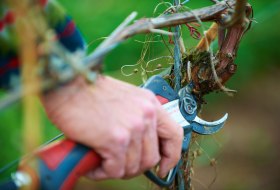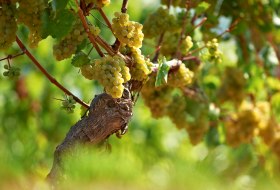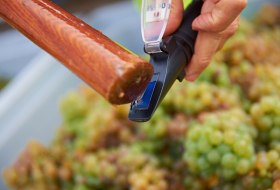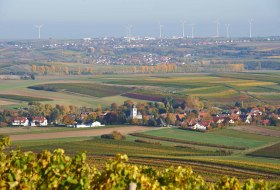
searchMenu



German expression for the quality wine assessment. German wine law focuses on "quality in the glass". Therefore, a wine may only be designated and marketed as a quality wine or predicate wine, if the winmaker applies for it and it is granted an official examination number (German: "A.P-Nummer") and a predicate. The examining authority (in Rheinhessen this is the Alzey testing center at the local viticulture office) makes the final decision based on the results of an anaysis in an approved laboratory and a sesory analysis by a…

Typical nonsense word from Mainz without ascertainable word origin. Mostly, such words are born from the fantasy of advanced wine hours. The Radaddelche, like much in Mainz, is a kind of parody of medals and decorations and similar "adherents." They are funny colorful cross loops worn by associations, such as Mainzer Weinzunft or Weinbruderschaft Rheinhessen, to externally portray togetherness.

Dangerous grape vine pest, which was imported to Europe around 1860 with imported rooted vines from North America. Within two centuries, it almost completely destroyed the European vineyads. Phylloxera sucks the roots of the vines and causes them to die. In order to protect the vineyards from this pest, until today, all European vines are placed on American rootstocks, as only those are resistant to Phylloxera.

During the dormancy, in winter or in early spring, the vines are cut by hand. The ajority of the wood that grew throughout the last year is take out and only one or two of the strongest branches are left. Through proper pruning, which requires expertise and quality consciousness, the growth of the vine is steered, its age and health determined and the right balance of goodness and quantity given.

The grape variety is one of the factors that influence the quality and taste of a wine. The grape variety may be indicated on the label, however, that is not mandatory. Link to the description of the individual grape varieties

Optical, telescope-like device for determining the must weight of ripening grapes in the vineyard. The refraction of light is measured and thus the sugar content is determined on a measuring scale.

It refers to the unfermented sugar in the wine, that is left from the grapes. It is given in g/l.

Hill country located in the turn the river Rhine is making between Bingen, Mainz, Worms, Alzey and Bad Kreuznach. Surrounded and protected by Hunsrück, Taunus, Odenwald and Palatinate Forest. In the triangle of the A 60, A 61 and the Rhine; Part of the country Rhineland-Palatinate. Ancient settlement land, rich in cultural heritage. Largest wine growing region in Germany.

The area wine advertising based in Alzey was founded in 1961. The purpose of the association is to promote the sales of Rheinhessen wines at home and abroad. Community advertising promotes Rheinhessen wine as "Die Weine der Winzer" (engl.: the winemaker's wines). It provides its members with advertising material, advice, trade contacts and training opportunities. Rheinhessenwein e.V. is the central information office for all questions about wine from Germany's largest wine-growing region. Link to Rheinhessenwein eV / About us

German expression for Rheinhessen hill country. It is the geographical and generally viticultural term for all the villages in the Rheinhessen region, which are not directly located by the Rhine, including the Wonnegau.